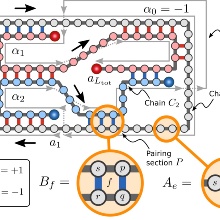Quantum many-body phenomena
Our research topics are the exploration of quantum many-body systems realized with cold atomic and molecular gases as well as photons interacting with atomic gases. The focus is on the search for novel states of matter, such as exotic and topological phases, as well as their application for quantum information processing and quantum simulation. This interdisciplinary research field combines aspects from condensed matter physics, quantum optics, atomic and molecular physics, as well as quantum information theory. The methods to tackle these problems are mainly based on well established analytical tools to address quantum many-body systems, but we also resort to numerical methods if required by the complexity of the problem. In the following, we provide an overview on our research topics.
Further information
Selected Projects
Funding: ???
Quantum computing with Rydberg atoms
More coming soon ...
Further information
Selected Projects
Funding: ERC SIRPOL
Topological states of matter
Systems characterized by topological invariants are well-known for their unique properties and phenomena with a plethora of potential applications in quantum information processing and engineering. Following their first experimental observation with the integer quantum hall effect, many other condensed matter materials have been identified and experimentally characterized, such as fractional quantum Hall fluids and topological insulators and superconductors. The former is a state of matter characterized by topological order with the unique feature of localized quasiparticles with emergent non-trivial statistics — so called anyons. One of the main questions is whether it is possible to realize such novel states of matter in artificial materials like cold atomic gases, polar molecules, and/or interacting photons to unravel their properties and identify potential applications in quantum information processing.
Further information
Selected Projects
Funding: EU RySQ
Rydberg atoms
The most remarkable property of Rydberg atoms is their extremely strong van der Waals and dipolar interaction which extends over distances larger than the optical wave lengths. This strong interaction entails the so-called Rydberg blockade: once a Rydberg state is created, the surrounding atoms are shifted out of resonance with the exciting laser due to the strong interaction. As a consequence, the number of excited Rydberg atoms is strongly suppressed. This has remarkable consequences and applications such as a universal behavior of the fraction of excited Rydberg atoms and the efficient implementation of quantum gates. Furthermore, it may allow for the realization of quantum simulations of systems with strong many-body interactions by means of a digital Rydberg quantum simulator. The theoretical advances are accompanied by fast experimental progress in trapping individual Rydberg atoms in arbitrary 2D and 3D lattice structures by optical tweezers. The main goal in this project is to understand the microscopic interaction between Rydberg atoms, search for the realization of strongly interacting quantum many-body states, and explore the collaborative enhanced interactions between light and Rydberg superatoms.
Further information
Selected Projects
Funding: FOR 2247
Cold atomic gases and molecules with dipolar interactions
Quantum degenerate gases of atoms and molecules with strong dipole moments are currently an intense field of research due to the potential to observe and design strongly correlated states of matter. The main approach to cool polar molecules is based on the coherent association in a two-species cloud of ultracold atoms. A special property of polar molecules is their permanent electric dipole moment that gives rise to tunable dipole-dipole interactions. The most remarkable consequence of this strong interaction is the formation of a crystalline phase for polar molecules confined to two-dimensions. Alternatively, cold atomic gases with large magnetic dipole moments have recently emerged as a highly promising approach to study dipolar interactions in the quantum degenerate regime.
Further information
Selected Projects
Funding: SFB TRR21
Cold atomic gases in optical lattices
While cold atomic gases are in general weakly interacting, opitcal lattices open the potential to reach the strongly interacting regime by suppressing the tunneling between the different lattice sites. This field was pioneered by the theoretical prediction and subsequent experimental observation of a quantum phase transition from a superfluid to a Mott insulator. In recent years, a large variety of different lattice geometries in different dimensions for fermionic and bosonic atomic species as well as mixtures have been experimentally realized. The focus in this project is to study strongly correlated states using this atomic lattice toolbox.
Further information
Selected Projects
Funding: ERC SIRPOL
Strongly interacting Rydberg polaritons
A fundamental property of optical photons is their extremely weak interaction, which can be ignored for all practical purposes and applications. This forms the basis for our understanding of light and is at the heart of the rich variety of tools available to manipulate and control optical beams. On the other hand, a controllable and strong interaction between individual photons would be ideal to generate non-classical states of light, prepare correlated quantum states of photons, and harvest quantum mechanics as a new resource for future technologies. Rydberg slow light polaritons have recently emerged as a promising candidate to reach this goal and first experiments have demonstrated a strong interaction between individual photons. The aim of this project is to develop and advance the research field of Rydberg slow light polaritons with the ultimate goal to generate strongly interacting quantum many-body states with photons.









